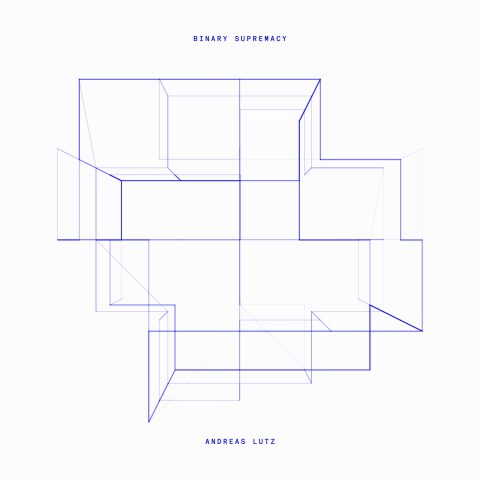In his follow-up to Zwölftonform (2016) Andreas Lutz presents his latest set of eight new pieces, Binary Supremacy. The Kasuga Records (Berlin) release is in a limited edition of 100 copies via SD card and digital. The offering is quite unusual and off the beaten track, yet has a resounding balance between minimal techno and abstract sound art. He is an artist who has shown internationally and who deploys his work in installation form (which I can, of course, appreciate). Lutz’s works, while experimental, have a form and structure that seem somewhat familiar, however ‘machine-made’ they may appear.
It starts in silence as Nulled Fields slowly opens its shadowy curtain. The soft ambient layers dangle and drift as a slight bouncing percussion and vague white noise emit from left and right. It’s a sparse minimal techno submerged in a levitating, fluid, diffuse setting without edges. Pixelated micronoise mimics the simple percussive element. This sets the stage for a much more bouncy Restructuring. I’m considering the blueprint-like cover art as this piece plays, that cyanotype-colored line drawing, along with visions of ‘Pong’ dancing in my head. It’s not on the buoyancy of the percussion, but there’s a steely approach to the composition – it’s playful and animated yet it still retains a certain reserve and complexity.
Analog Road and Super Constructor both use voice, edited and repeated in clean cut-ups, the mix along with the staccato single beats and elongated, broken drone is unique in its fragility. The latter counts down the digitized universe of 1s and 0s with the assistance of a robotic voice – think a stripped down Kraftwerk in those fateful days making Pocket Calculator. It plays on how the information age, the digital age and humankind have come to a point of inevitable assimilation. Buffer is just that, an intermediate placeholder. Transmission Heap is a very abstract, minimal cut-up of disintegrated voice bits and the earliest of arcade games. It moves along nicely, as if it’s teasing to lash out into a techno assault, but resists completely. Instead it sounds more as though Lutz is under the hood trying to fix this replicating machine that is spitting out encoded information.
Digital daydreaming: In the final stretch Return is a mostly quiet piece that creaks gently, moving back and forth from left/right channels with these small actions, and other electronics. Closing with Write Pulse, a string-like reverb seems to attempt to identify the parameters of the physical space as one that is slightly claustrophobic and/or closing in. With static and other microsound effects it sounds as if a laboratory experiment is underway, however incoming is a nice broken melody that ties together the ambiguous activity. Lutz saved the best for last as this one opens so curiously and blossoms with a warmth unseen elsewhere on this recording. An atmospheric ending, a tipping point, in anticipation, a segue to the future. This is not only serving to count digits ad nauseama, it’s a trippy, cerebral record with playful pockets – definitely one for repeat listening.
— TJ Norris via Toneshift
